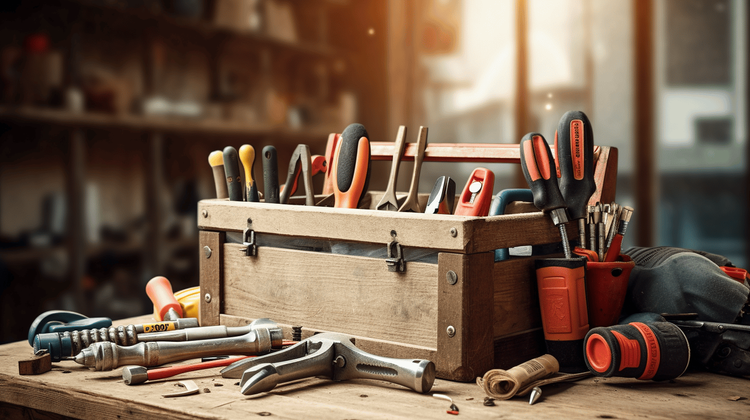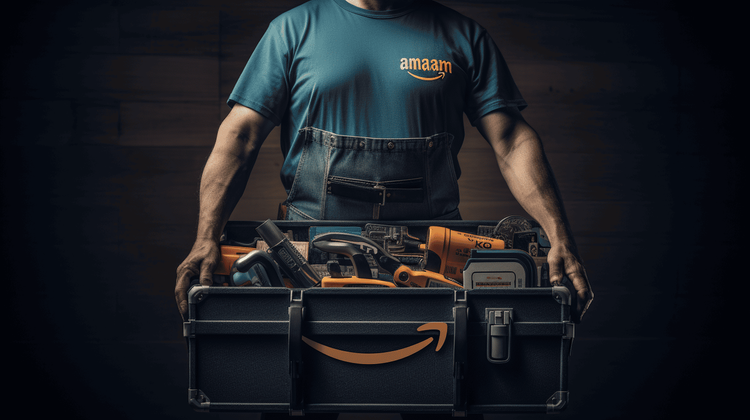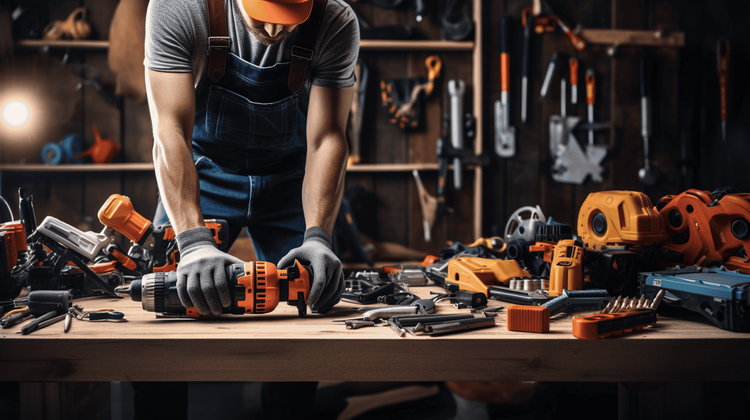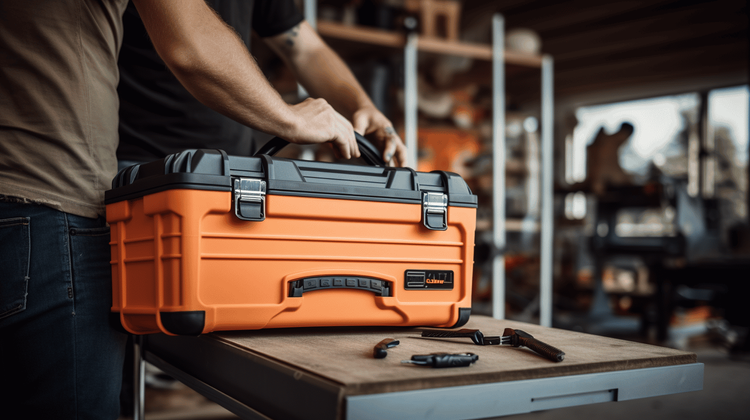Thrifty Handyman: Finding Affordable Tools for your DIY Projects
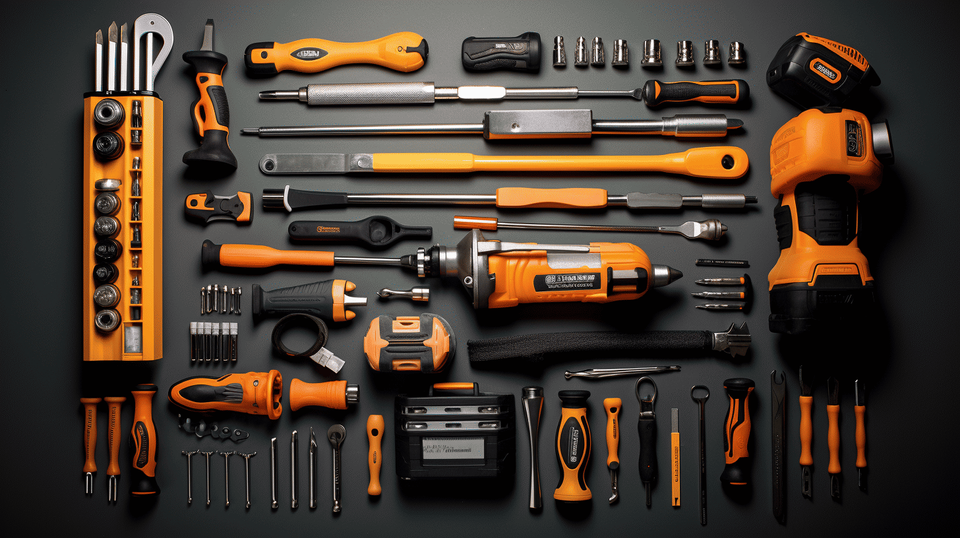
Welcome, thrifty handymen and handywomen of the world! 👋 We all know that DIY projects can be a great way to save money, learn new skills, and transform our living spaces. However, a successful DIY journey often demands a collection of reliable tools at our disposal. But here's the catch - tools can be expensive, right?
Not always, and that's the good news! You don't need to splurge on high-end tools to become a savvy DIYer. By making informed decisions, you can find affordable, yet sturdy tools that successfully cater to your projects, without burning a hole in your pocket. 💲
Throughout this DIY-loving adventure, the guide will walk you through understanding your project requirements, uncovering handy tips on finding 'budget-friendly meets quality' tools, recognizing tool safety considerations, the pros and cons of renting versus buying tools, and top-notch ways to maintain and care for your tools to keep them long-lasting.
So, let's roll up our sleeves and start mastering the art of thrifty tool collecting for your DIY projects. After all, it’s not just about finding the right tools, but finding them at the right prices too! Let's kick start our budget-friendly journey! 🛠️
Understanding DIY project requirements
Embarking on a DIY project can be a thrilling adventure, spurring you forward in a journey of creativity, resourcefulness, and, at times, sheer determination. Yet, like any expedition, the path to a successful outcome begins with thorough preparation and understanding the requirements. An essential part of this involves identifying the necessary tools and evaluating the project's complexity. Once equipped with this knowledge, you'll be in a much better position to see your DIY dream become a satisfying reality.
Identifying necessary tools
Just as a painter wouldn't set out to create a masterpiece without their brushes, so too does any DIY enthusiast need to arm themselves with the right tools before diving into a project. Identifying and gathering these elements can save time, resources, and potential frustration down the line. 🛠️💡🧰
It may be useful to:
- Conduct thorough research on your required tools.
- Assess what you already possess from a previous project.
- Consider borrowing some tools if possible to save costs.
Strongly consider investment in essential durable tools with a wide variety of uses such as hammers, screwdrivers, and adjustable wrenches. These items will serve you well in numerous future DIY undertakings as well.
Evaluating project complexity
Equally crucial to understanding DIY project requirements is discerning the complexity of the assignment. By gauging the project’s intricacy, you gain a realistic grasp of the tasks ahead. This can help in setting achievable goals, allocating enough time for the project, and avoiding unnecessary disappointments when hurdles might arise. 📚🔍⏳
Assessing complexity might involve:
- Checking if the project requires special skills.
- Determining the anticipated time for completion.
- Analyzing if professional help may eventually be needed.
Don't let the complexity of a project deter you, though. Some of the most rewarding DIY projects are challenging, pushing boundaries and helping you grow in ways expected.
Remember, every successful DIY project starts with understanding its requirements. By identifying the necessary tools and evaluating the complexity of the task, you're laying down the groundwork for a successful project that's both enjoyable and highly rewarding. Now that's the true beauty of DIY!
Ways to Find Affordable Tools
Starting a home project or a new hobby? Need tools but your budget is a bit tight? Don't fret! With a little bit of research, knowing where to look, and a bit of patience, you can find affordable tools that will cater to your needs without breaking the bank. This article will guide you through the various avenues where you can find such tools.
Sales and Clearance Sections
One of the most obvious places to look for affordable tools is in the sales and clearance sections of hardware stores. 🕵️♂️
- Both physical and online stores often have these sections where they sell items at reduced prices.
- Retailers usually offer discounts on older models once a new one is released - this can be a great opportunity to score quality tools at a bargain.
- Look out for annual or seasonal sales where discounts can reach up to 70% off! Remember, patience pays off.
"Savings can sometimes come in the unlikeliest of places. Standing firm on your budget can push you to explore and stumble upon the clearance section, which is a treasure trove of great deals waiting to be discovered." is a quote that illuminates this category perfectly.
Second Hand Tools
Sometimes, the best deals are found when you buy second-hand tools. After all, tools are built to last, so even if they’re not brand new, they could still offer you a good run. 👌
- Look out for garage sales in your neighborhood or look up local ad listings.
- Online classified websites can also be a source of second-hand tools.
- Make sure to inspect the items for any damage before purchasing.
Online Shopping Platforms
Online shopping platforms have changed the way we buy — and tools are no exception! This method is arguably one of the most convenient ways to find affordable tools. 💻
- Keep an eye out for deals and discounts that are exclusive to e-commerce platforms.
- Take advantage of the review system to check the quality of the tools, as they can offer insights that can help you make a sound purchase.
- Some e-commerce platforms even offer price comparisons to ensure you are getting the best deal possible!
Community Tool Libraries
Last but not least, check out community tool libraries. Not everyone is aware of this, but tool libraries are a thing, and they're a clever way to save money. 🏛️
- Community tool libraries work on a borrowing system, where you can borrow the tools you need for a certain amount of time.
- They usually require membership, but the cost is significantly lower than buying new tools.
- This is a great option for one-time projects, where you're not likely to use the tool again.
As you can see, there are plenty of ways to find tools without having to pay a premium price. Whether you're a DIY enthusiast, a budding craftsman, or someone who needs tools for practical purposes, these options can help you acquire the tools you need, all the while keeping to your budget. Remember, the most expensive option is not always the best — sometimes, the best value can be found in the most unexpected places. Happy tool-hunting! 🔧 🛠️ 🧰
Determining Tool Quality
When working with tools, quality is key. No one wants to spend an exhausting afternoon on a DIY project, only to find that their tools can't accomplish the job properly, or have shattered under the strain. To avoid this frustrating scenario, it's important to understand how to determine tool quality. This information guides users to make a more informed decision, and ensures that the tools they pick are durable, reliable, and worth every penny spent.
Researching Online for Tool Quality
Long gone are the days when a trip to the store was the only way to check tool quality. There is a gold mine of information right at everyone's fingertips through online research. Before clicking the "Buy Now" button, take a few minutes to:
- Look up the tool manufacturer: Some manufacturers are well-reputable for their tool quality.
- Seek out user experience: Forums, social media pages and comments sections often have invaluable first-hand experiences of individuals who have used the tools.
- Compare prices: While higher prices don't always translate to better quality, suspiciously cheap tools might be a red flag for low quality.
Reading Product Specifications
Remember the old saying, "The devil is in the details"? It applies perfectly when determining tool quality. Descriptions and product specifications can be enlightening. Check for:
- Materials used: Higher quality tools are usually made with durable, strong materials.
- Dimensions and weight: The size and heft of a tool can sometimes provide hints about its build quality.
- Product's lifespan: Some tools are designed to last for longer and handle rugged use.
Understanding Online Ratings and Reviews
When you're neck-deep in deciding between two different brands of drills, the tie-breaker could lie in the online ratings and reviews. It's important to remember a few things:
- Not every low rating translates to a poor-quality tool: Reviewers might have had unique issues or unmet high expectations.
- Watch out for patterns in reviews: If a specific issue is consistently being mentioned, that's something to consider.
- Analyze ratings from multiple sources: Don’t just stick to one platform, look around and compare.
But remember, a beautiful combination of online research, careful regard of product specifications, and insightful comprehension of reviews is the best strategy when determining tool quality. 🛠️ It helps make better decisions and ensures that you acquire tools that are genuinely worth the investment. Remember, a good tool can make the job you're doing quicker, easier and even more enjoyable, so choose wisely.
Safety Considerations when Buying Used Tools
We’ve all heard the adage before: a craftsperson is only as good as their tools. In a world going green, buying used tools is an excellent way to do your bit for the environment and save money, but there are safety aspects to consider. Buying used tools is not only a case of look, see, and hope for the best. 👀 The prospective buyer has an essential role in ensuring their safety, and there are a few key considerations to bear in mind. 🧰
Checking for Damage or Wear
Before you even think about parting with your hard-earned cash, a careful examination for damage or wear and tear is crucial. Yes, the tool might look old, but does it show signs of excessive misuse? Or worse, neglect? So how do you determine a well-loved tool from a poorly maintained one? 🤔
- Look for Rust and Corrosion: Metal components should not have any corrosion or rust. Significant rusting can weaken the tool, making it unreliable and potentially dangerous.
- Check for Broken or Missing Parts: Broken handles, missing screws, or any otherwise incomplete parts are a big no-no.
- Examine the Wiring: If the tool is electrical, inspect the wiring. Any exposed or frayed wires are not only an electrical hazard but can cause severe shocks or spark fires. 💥
Understanding Safety Standards
In addition to checking for apparent physical damage, understanding safety standards are crucial when purchasing second-hand tools.
Some key points to consider are:
- Certifications and Safety Marks: Look for safety marks such as CE or UL, which demonstrate compliance with safety standards. These marks indicate the tool has undergone testing and is safe to use. 👍
- Recall Information: Check if the tool has been recalled in the past due to safety issues, and if so, whether these issues have been addressed.
Proper Maintenance of Tools
Once you've got your hands on a second-hand tool, remember it's only as safe as its owner. Even the best tools can become hazardous if neglected.
To ensure the longevity and safe operation of your used tools, consider the following:
- Clean Tools Regularly: Keeping tools clean and free of dirt and grime can help them function properly and reduce the risk of accidents.
- Store Tools Safely: Proper storage goes a long way in maintaining the integrity of your tools. After all, what is a perfectly functioning saw if it's so blunt it couldn't cut a twig?
- Regular Inspections: A routine inspection of your tools not only affirms their health but could also save you from potential harm.
Remember, safety should always be a top priority. Buying used tools is economical and environmentally friendly, but one must remain diligent to maintain their well-being and those around them. With the right checks in place, you can enjoy the benefits of your tool and safeguard against potential hazards!
So go ahead, get that bargain tool, give it a second life, and work your magic! 🛠️ Just remember to stay safe!
Renting Tools Vs Buying for DIY Projects
If you've ever delved into the world of DIY, you'll know this dilemma all too well: to rent or to buy your tools. While both options come with their own set of pros and cons, the crucial factors often boil down to cost, the terms of tool rental, and an evaluation of future need for the tool.
Analyzing Cost for Renting Vs Buying
When it comes to DIY projects, the cost is indeed a major factor 🤔. Yet, the equation isn't as simple as comparing rental prices to purchase prices. Here are some factors to consider:
- Rental Rate: Are you being charged on an hourly, daily, weekly, or monthly basis? Think about how long you’ll need the tool and do the math to figure out the total cost.
- Purchase Price: Consider the initial investment of purchasing the tool.
- Lifespan: If you buy, how long is the tool likely to last? Don't forget to factor in maintenance costs as these can add up.
- Resale Value: If you decide to sell the tool down the line, how much of your initial investment could you recoup?
In case you're interested, our DIY Budget Calculator could help you weigh out these factors.
Understanding the Terms of Tool Rental
Renting tools come with terms and conditions 😇. It’s crucial to understand these before you commit. Here's what to look out for:
- Contract: The rental contract outlines how the tool can be used. Make sure these conditions suit your project needs.
- Rental Duration: The length of the rental period might affect pricing. Are you only allowed to rent for a specific time or can you extend if needed?
- Liability: If the tool gets damaged during your rental, who pays for it? Ensure that you understand the terms about damage and liability.
- Delivery and Pick-Up: Some companies offer delivery and pick-up services for rented tools. Check if this is included in the rental fee or if it comes with additional charges.
Evaluating the Need for the Tool in Future
One of the key factors for deciding between renting and buying is evaluating how much use you expect to get from the tool in question 🤷♀️. Here’s what to consider:
- Frequency of Use: If this tool is going to sit in your garage collecting dust after one project, renting it might be the smarter option.
- Variety of Uses: Does the tool serve multiple purposes? If it's versatile, then buying it might be beneficial in the long run.
- Learning curve: Some tools require training to operate safely and efficiently. If you’re considering buying, ask yourself if you’re willing to invest the time and energy to learn to use it properly.
Ultimately, the rent vs buy decision is a personal one, hinging largely on your project needs, financial means, and long-term plans. Remember, the best-suited tools are not just about getting the job done, they're about getting the job done well. Happy DIY-ing! 🛠️
Maintenance and Care for Keeping the Tools Long Lasting
The heart of a craftsman's work lies primarily in their tools. Just as a painter caresses each stroke with their brush, or a chef whisks away with their favorite wooden spoon, the same applies to crafters and their beloved tools. Figuring out how to care for them can be a daunting task, but the reward of well-preserved tools is worth the effort. Preservation maintains a tool's lifespan and ensures a craftsman's trust in the reliability of their instruments. So, let's cut through the chase, roll up our sleeves, and learn the best ways to care for and maintain our cherished tools.
Regular Tool Maintenance Practices
Consistent tool maintenance is not just about keeping them nice and shiny; it's a commitment. One from which you reap benefits in the shape of long-lasting, high-performing tools. Here are a few pointers to steer you in the right direction:
- Lubrication: Tools with moving parts, like drills and saws, need frequent lubricating to ensure smooth operation. A squirt of good quality lubricant would be enough to keep the parts moving easily.
- Sharpening: For cutting tools, regular honing keeps them sharp and efficient. It's recommended to use a sharpening stone or a file to maintain the cutting edge.
- Tightening: Tools like wrenches, hammers, and screwdrivers have parts that can loosen over time. Regularly check and tighten them as required.
flicks sweat off forehead Phew! That was some heavy lifting. Now, let's move on to tool storage.
Proper Tool Storage
Ever heard the phrase "A place for everything and everything in its place"? It holds true, even for tool storage. Tools carelessly tossed into a drawer are more likely to get damaged. Here are some great storage tips for your tools:
- Toolbox: Invest in a sturdy toolbox with compartments for different types of tools. The organization is key to easy access and extends a tool's life.
- Pegboard: This wall-mounted storage solution is perfect for hanging tools, making them easy to see and access.
- Climate-controlled storage: Tools stored in harsh conditions are prone to rust and other damage. A climate-controlled storage space ensures your tools stay in top condition all year round.
Let's not forget about cleanliness- arguably, one of the most important aspects of tool maintenance. No worries, though. We've got you covered!
Keeping Your Tools Clean
Dirt and grime are the worst enemies of your tools. And who wants a rusty shovel or a grimy saw? Nobody! Here are a few cleaning tips:
- Wipe Them Down: After every use, make sure to wipe your tools clean with a dry rag. Remove any excess dirt or grime, and don't forget those hard-to-reach corners.
- Deep Clean: A deep cleaning session every now and then helps to keep your tools in top-notch condition. Warm soapy water and a stiff brush can work wonders. Just make sure to dry them off properly afterward to prevent rust.
- Rust Prevention: Applying a thin layer of oil to your tools can help prevent rusting. A tool free of rust is a happy tool!
As the saying goes, "Take care of your tools, and they'll take care of you." Remember that every minute spent on tool maintenance is a priceless investment towards their longevity. And hey, who doesn’t like the sight of a clean, well-organized workspace? Definitely gives ⭐⭐⭐⭐⭐ to any craftsman's station. Embrace these practices, and enjoy the results!
Conclusion
Thrifty Handyman: Successful DIY and You
Now that you're equipped with handy tips and insights on finding affordable tools for your DIY projects, it's time to dive in and get started. Keep your project requirements in perspective, always prioritize safety considerations, and don't forget to explore cost-effective options. Whether it's purchasing new, gently used, or even renting, the perfect tool is out there waiting for you.
Balancing affordability and quality might seem challenging, but with proper research, it doesn't have to be. Remember, it's not just about buying the most inexpensive tool — the secret lies in finding a high-quality tool that will not just last, but also contribute to the success of your DIY endeavors.
For instance, take the Bit Holder Keychain from Ultra Handy. It's a great example of a cost-effective, high-quality tool that erases the hardship of organizing your screwdriver bits. No more fumbling to find the right size in the middle of a project. Convenient, isn't it? You can find it here on our eCommerce Amazon store.
Remember, price isn't the only marker of quality. Investing time to properly maintain and care for your tools will ensure they last longer and serve you well.
In the end, it's the skill in your hands, empowered by the right tools, which will transform your DIY project from an idea on paper into reality. And at Ultra Handy, we’re honored to support you every step of the way. Now, it's your turn to roll up your sleeves and bring your vision to life!
Happy DIY-ing! Let's continue to build, create, and make with our own hands. After all, there's nothing quite like the satisfaction of standing back and looking at a job well done, knowing it was crafted with persistent effort, creativity, and all in your own unique way.
Frequently Asked Questions
- Where can I find affordable tools for my DIY projects?There are several places where you can find affordable tools for your DIY projects. Some options include checking out local hardware stores, browsing online marketplaces like Amazon or eBay, attending garage sales or auctions, and joining online DIY communities where members often sell or trade tools at reasonable prices.
- Are there any specific brands that offer affordable tools for DIY projects?Yes, there are several trusted brands that offer affordable tools for DIY projects. Some popular options include Stanley, Craftsman, Ryobi, Black+Decker, and Kobalt. These brands offer a wide range of tools that are not only budget-friendly but also reliable and durable.
- What are some tips for finding the best deals on tools?To find the best deals on tools, it's recommended to compare prices from different sellers or websites, subscribe to newsletters or follow social media accounts of tool retailers for exclusive discounts, consider purchasing used tools in good condition, and keep an eye out for seasonal sales and promotions.
- Is it worth investing in quality tools even if they are more expensive?Yes, investing in quality tools is worth it in the long run. While they may be more expensive upfront, quality tools tend to last longer, perform better, and require fewer repairs or replacements. They can also enhance the safety and accuracy of your DIY projects.
- Are there any rental options available for tools?Yes, renting tools can be a cost-effective option, especially for tools that you may only need for a specific project or occasional use. Many hardware stores and home improvement centers offer tool rental services, allowing you to access a wide range of tools without the need for long-term ownership.
